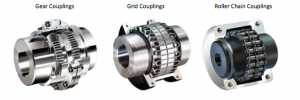Small Parts with Big Responsibility: an Introduction to Flexible Couplings
Across industries, flexible couplings protect machinery from stress, wear, and costly machine downtime. These components, although usually small in comparison to the equipment they connect, play a very large role in equipment reliability. When properly selected, installed, and maintained, they can help to significantly prolong the life of your equipment.
In an ideal world, industrial operators wouldn’t need to rely on flexible couplings, as their machinery would operate in perfect alignment at all times. However, in the real world, it is likely that your equipment will occasionally slip into slight degrees of misalignment placing additional stress upon the connected gears and bearing systems.
Here’s where flexible couplings come to your rescue:
The primary functions of flexible couplings are to connect equipment at the ends of two shafts, transmit torque, and accommodate some degree of shaft misalignment. A secondary function of the flexible coupling is to provide some torsional flexibility and shock load protection to the connected equipment.
Even though the flexible coupling compensates for some misalignment, it should be stressed that maintenance personnel should be aware of the maximum mis-alignment specification established for a given coupling. This will require the maintenance personnel installing the equipment to check each one, measuring and adjusting the connector appropriately to within these specifications. This ensures that everything will function properly in accordance with the coupling design during operation. Coupling manufacturers will provide these specifications along with the proper coupling recommendations for a given application.
There are three kinds of mechanical flexible couplings that require lubrication
In such applications, operators will need a viscous lubricant to protect these small parts supporting very heavy loads. Grease is usually the lubricant of choice for flexible couplings due to the ease of application and the ability to keep it in the assembly.
Properly formulated coupling grease stays exactly where it’s needed; making it ideal for applications that cannot be frequently relubricated. During operation, the thickener of the grease will hold the lubricating oil in reserve until external forces, such as movement, vibration, and temperature, trigger its release into the system. As couplings rotate, the centrifugal forces within the application force the grease to the outer circumference of the coupling’s inner cavity, where it engages between gear teeth to form a film and prevent wear.

